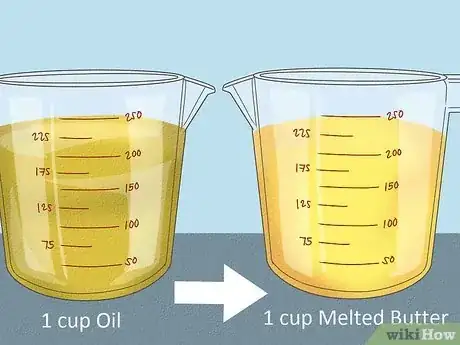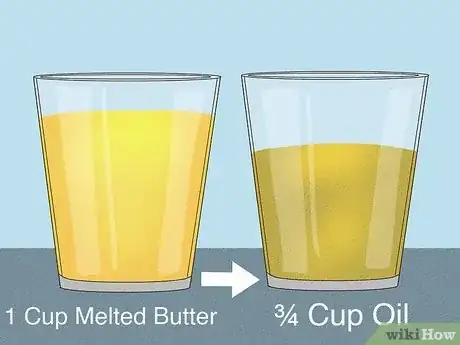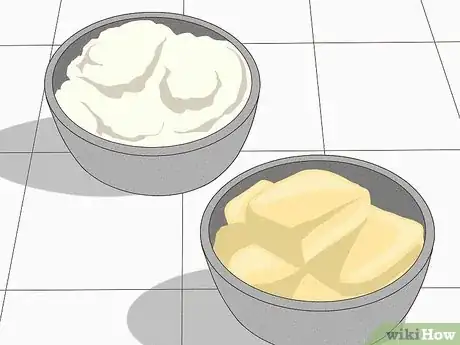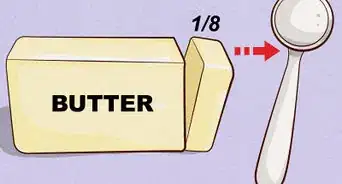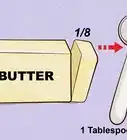This article was co-authored by wikiHow staff writer, Johnathan Fuentes. Johnathan Fuentes is a writer based in the New York City region. His interests as a writer include space exploration, science education, immigration, Latinx cultures, LGBTQ+ issues, and long-form journalism. He is also an avid hiker and has backpacked in Alaska and Newfoundland, Canada. A son of Cuban immigrants, he is bilingual in English and Spanish. Prior to joining wikiHow, he worked in academic publishing and was a freelance writer for science websites. He graduated from Columbia University in 2021, where he studied nonfiction writing and wrote for the student newspaper. He is currently counting down the seconds until the release of Kerbal Space Program 2 in 2023—a game that will almost certainly take up what little free time he has.
There are 16 references cited in this article, which can be found at the bottom of the page.
This article has been viewed 3,010 times.
Learn more...
A cup of oil or a stick of butter makes almost anything taste good. It’s no wonder why we add oil and butter to so many recipes—but what if you need to substitute one for the other? There are lots of reasons for doing this, from cutting back on dairy to giving your muffins a cakier, buttery texture. It’s also super easy once you get the hang of it. Here’s a guide for substituting butter for oil, and oil for butter.
Steps
Baking with Oil Instead of Butter
-
1Replace the melted butter with ¾ the amount of oil. For example, if your recipe calls for 1 cup of melted butter, replace it with ¾ cup of oil.[10] Melted butter is part water, part fat, whereas oil is 100% fat. Putting ¾ the amount of oil ensures that your recipe has the correct amount of fat.
- Try using an oil that compliments your recipe. Canola oil, olive oil, and grapeseed oil are more “neutral,” meaning they have less effect on the taste of baked goods.[11]
- Coconut, sesame, macadamia, avocado, and nut oils have strong flavors that stand out. This can be a good thing if it compliments the recipe. For example, banana bread is made with nuts, so walnut oil would make a great butter substitute.[12]
- Shortening can also be replaced with oil in some baking recipes—but not always. Don’t use oil instead of shortening in pie dough, biscuits, or scones. They won’t puff up properly.[13]
-
2
References
- ↑ https://bakinghow.com/vegetable-oil-substitute/
- ↑ https://bakingbites.com/2013/04/how-long-should-melted-butter-cool-before-using-it-in-a-recipe/
- ↑ https://www.washingtonpost.com/food/2021/06/23/baking-with-oil-not-butter/
- ↑ https://bakinghow.com/use-margarine-in-cookies/
- ↑ https://www.bhg.com/recipes/how-to/bake/how-to-substitute-butter-for-shortening-when-baking/
- ↑ https://www.bhg.com.au/substitute-for-vegetable-oil-alternatives-to-vegetable-oil
- ↑ https://health.clevelandclinic.org/what-you-should-know-about-cholesterol-and-butter/
- ↑ https://spoonuniversity.com/lifestyle/clarified-butter-vs-ghee
- ↑ https://www.foodnetwork.com/how-to/packages/food-network-essentials/best-shortening-substitute
- ↑ https://www.washingtonpost.com/food/2021/06/23/baking-with-oil-not-butter/
- ↑ https://sarakidd.com/top-5-tips-for-choosing-the-best-oil-for-baking/
- ↑ https://www.washingtonpost.com/food/2021/06/23/baking-with-oil-not-butter/
- ↑ https://www.thepioneerwoman.com/food-cooking/cooking-tips-tutorials/g34577150/shortening-substitute/
- ↑ https://jamiegeller.com/guides/how-to-bake-cookies-without-margarine/
- ↑ https://www.godairyfree.org/dairy-substitutes/how-to-substitute-oil-for-butter/
- ↑ https://jamiegeller.com/guides/how-to-bake-cookies-without-margarine
- ↑ https://www.baking-sense.com/2017/03/29/baking-ingredients-butter-fat/
- ↑ https://www.webmd.com/cholesterol-management/features/cholesterol-and-cooking-fats-and-oils
- ↑ https://www.foodnetwork.com/how-to/packages/food-network-essentials/best-shortening-substitute
